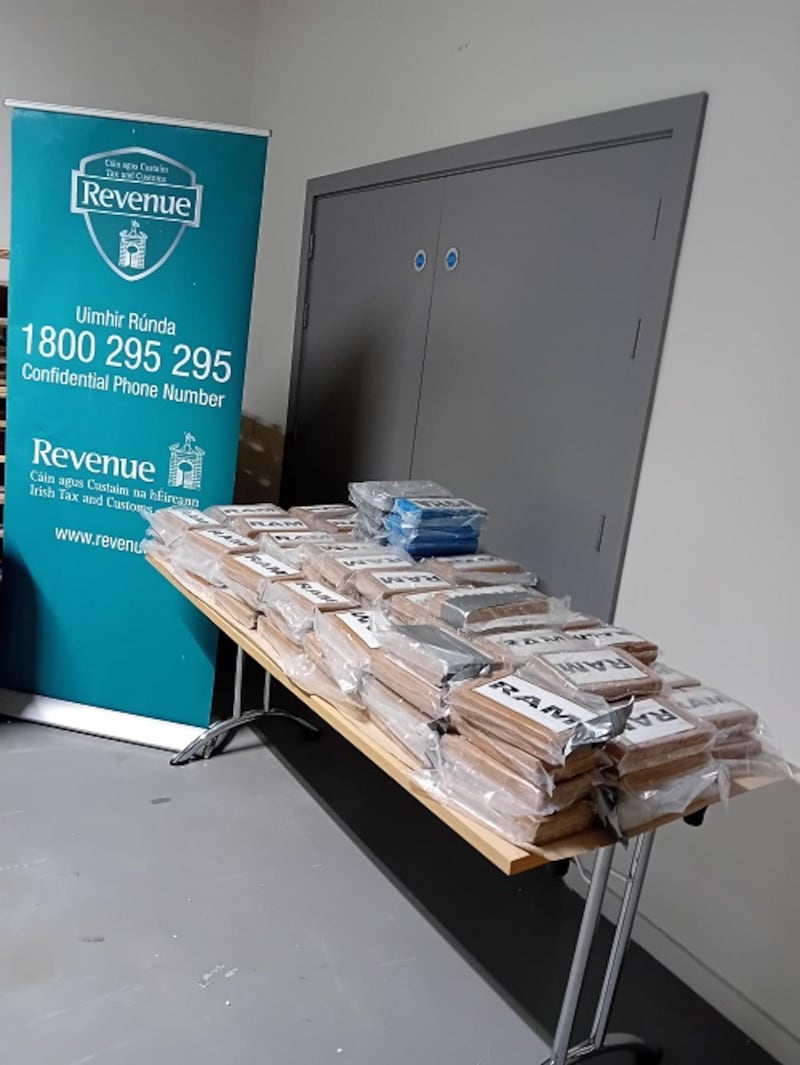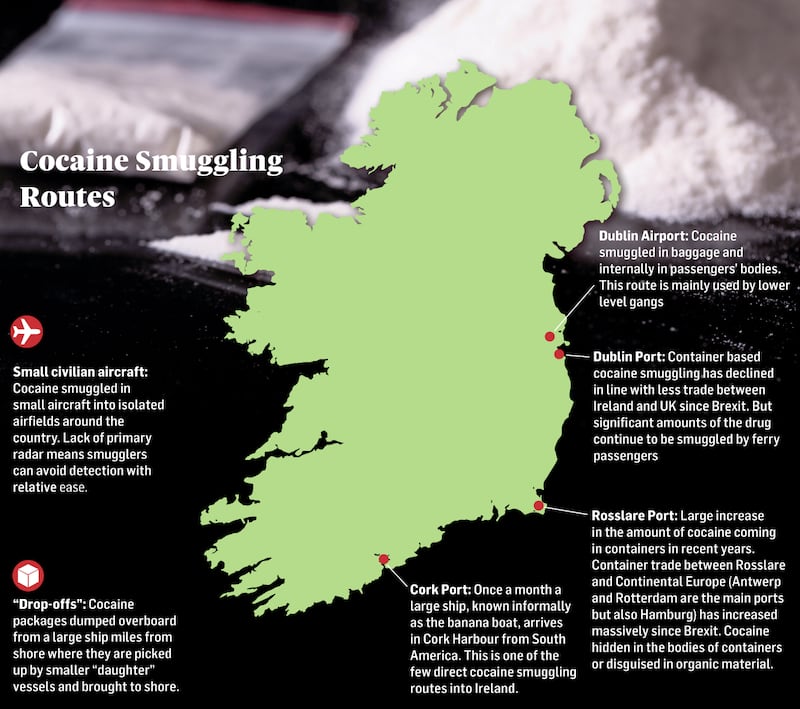When bales of cocaine started washing up on north Donegal beaches last month, Irish drug enforcement officials were quite sure what was happening.
The appearance of two 30kg bales, worth more than €4 million, had all the signs of a “drop-off” gone wrong. Drop-offs are a method of cocaine smuggling where a consignment is dropped over the side of a large ship and picked up a short time later by a smaller “daughter” vessel, usually a fishing boat or a pleasure craft, and taken ashore.
There is little sophistication involved. The packages are wrapped in black polythene and tied to five or six oil drums that keep them afloat and serve as a visual marker, says Andrew Ryan, maritime operations manager in the maritime unit of the Revenue Commissioners, the customs authority.
It is a popular method of smuggling among international drugs gangs, but carries significant risks, he says.
“Often there’s miscommunication between the vessels ... or the tides are stronger than anticipated. The drugs then end up washing ashore,” he says.
In the last nine months, 4,560kg of cocaine have washed up on European shores as a result of failed drop-offs. This suggests the figure for successful drop-offs is much, much higher.
Cocaine use has exploded in Ireland in recent years. This means criminals are willing to use risky and innovative ways to import the drug from manufacturing bases in South America.
According to recent studies, Irish people are the joint-fourth highest consumers of cocaine globally and the biggest consumers within the EU.
The trend is highlighted by seizure figures; so far this year, 555kg of cocaine have been seized by Irish law enforcement, including the 133kg seized at Rosslare Europort on Wednesday.
This has had dramatic consequences for Antwerp and Rotterdam, with criminals employing extreme violence, including murdering lawyers and journalists and setting up torture chambers
Estimated to be worth more than €9 million, the consignment was one of the largest cocaine seizures on Irish soil this year and was discovered in a container that had come in on a ferry from Dunkirk in France.
Cocaine seizures so far this year dwarf the total amounts seized in every other recent year except 2022.

The trend is partly driven by the increasing purity of cocaine. At retail level, cocaine purity in the EU has increased from 35 per cent in 2009 to more than 50 per cent in 2020.
Demand is facilitated by new smuggling methods that have emerged since Brexit dramatically shifted trade routes between Ireland and the rest of Europe.
Pre-Brexit, most cocaine came into Ireland through Britain. Now, it mainly comes in directly from the ports of Antwerp in Belgium and Rotterdam in the Netherlands and hidden in shipping containers.
Some 85 per cent of containers entering and leaving Ireland come from Dutch and Belgian ports.
Brexit has significantly altered cocaine smuggling routes, says senior Revenue official Shane Conway. Rosslare Europort has become busier, with new direct shipping routes to mainland Europe allowing trade to avoid new border controls after Britain left the EU. This, in turn, has changed how cocaine is trafficked, creating new supply routes for the criminal gangs out of continental Europe. So far this year, 330kg of cocaine has been found in shipments to Rosslare. The figure for Dublin Port is zero.
More ferry passengers and vehicles coming to and from continental Europe also provide new opportunities for smugglers. Last month 163kg of cocaine was found in Rosslare Port hidden in a horsebox.
Some concealment measures are as impressive as they are concerning. Gardaí seized €150,000 worth of cocaine that had been liquidised and smuggled in wine bottles
A report last year commissioned by the British Embassy in Ireland concluded this would continue, as the UK “land-bridge” – the name describing the once preferred route to mainland Europe through Britain – becomes less important to Irish trade.
At the other end, northern EU ports that are doing record trade with Ireland have seen a large increase in shipments of cocaine directly from South America. According to the United Nations Office on Drugs and Crime, Antwerp and Rotterdam have “now eclipsed ports in Spain and Portugal as the main entry points for cocaine into the EU”.
The shift has had dramatic consequences for these cities, with criminals employing extreme violence, including murdering lawyers and journalists and setting up torture chambers, to maintain their share of the proceeds. At the same time corruption has become widespread.
“We definitely have the characteristics of a narcostate,” said Jan Struijs, chairman of the Dutch police union a few years ago.
The successful hacking by EU police forces of encrypted communications systems used by organised criminals shows how drugs gangs from various EU countries will often work together to bring in a shipment from South America.
The most notorious, known as the “Super Cartel”, which counts the Irish Kinahan gang among its members, is believed to be behind an effort in 2019 to smuggle 20 tonnes of cocaine, worth more than €1 billion, from South America.
Drugs gangs “don’t have state barriers,” says Detective Superintendent Joe O’Reilly of the Garda National Drugs and Organised Crime Bureau (GNDOCB). “Certainly, they work collaboratively to get their products landed whatever method they use.”
Ryan, the Revenue customs official, says that one of the most common methods of container smuggling is the “rip-off” method. Gangs will open a container in the source country and hide a consignment of drugs inside. The container will then be closed again.
Once it arrives in its destination port, criminals or corrupt port workers will break in and remove the drugs before the container can pass through customs checks.

Other methods include hiding cocaine in shipments of organic material, such as coffee, to disguise them from Revenue’s high-definition X-ray scanners or concealing the drug in the walls, floors or refrigeration units of containers, according to Conway. Sometimes glue, bleach or even cinnamon will be mixed in with the haul to throw dogs off the scent of the drugs.
Recently, criminals have also been disguising cocaine by mixing it into clothing, liquid or other substances. In 2021, customs authorities in Rotterdam port located half a tonne of cocaine, destined for Ireland, that was chemically mixed in with a shipment of charcoal.
Some of the concealment measures are as impressive as they are concerning. O’Reilly mentions a seizure by gardaí last year of €150,000 worth of cocaine that had been liquidised and smuggled in wine bottles, while Conway recalls the location in 2017 of a kilogram that had been chemically impregnated into a duvet.
“They are inventive, and they are sophisticated,” he says.
In 2021, a Dublin joint policing committee heard cocaine was allegedly being smuggled “in the vaginas” of low-value horses and donkeys.
The vast majority of cocaine arrives in Ireland through continental Europe or the UK. The only major exception is what is known colloquially the Banana Boat, a container ship that arrives into Cork from South America roughly every 10 days.
There are more than 100 private airfields in Ireland ... Most have no security or customs presence, meaning there is little to no risk involved in drug trafficking
As the only direct trade route for container traffic from South America, it attracts special attention from law enforcement. Several times a year, drugs shipments are found on the ship, having been loaded on to the ship without the knowledge of vessel’s owners, operators or crew.
Since 2017, 226kg of cocaine worth almost €16 million has been seized at Cork port.
Irish officials stress container smuggling is just one of many routes used by smugglers. Methods used to import cocaine into Ireland are unusually varied.
[ How cocaine became Ireland’s biggest drug problemOpens in new window ]
[ Drug taskforces turning addicts away amid a 400% increase in crack cocaine useOpens in new window ]
“You have to remain vigilant across all types of frontiers, be it postal hubs, airports, ports and the maritime domain,” says Ryan.
One vulnerability is the use of small private planes from France. There are more than 100 private airfields in Ireland, some of which are little more than fields. Most have no security or customs presence, meaning there is little to no risk involved in drug trafficking, unless the authorities are tipped off.
The scale of the problem was demonstrated last year by a Revenue and Garda operation when officers, acting on intelligence, seized €8.4 million worth of cocaine flown into the airfield at Abbeyshrule in Co Longford on a tiny aircraft.
At a lower lever, gangs will use the postal service to smuggle in smaller consignments, a method which became popular during the Covid-19 pandemic when traditional trade routes were disrupted.
The method has advantages and drawbacks. Cocaine stands a higher chance of being intercepted at postal centres but if it is found, the seizures are usually small, and the smuggler stands little chance of being arrested if they have taken precautions.
One popular method involves air and sea passengers smuggling cocaine internally. These “mules” are often vulnerable people who are asked to swallow up to a kilogram of the drug in the form of pellets.
Arrests are frequent. Revenue even has a specially adapted toilet to recover ingested cocaine from smugglers. The popularity of the method indicates significant quantities still get through.
Sharing information on routes and methods between international law enforcement is vital to staying ahead of the smugglers, says Conway.
“We will get bulletins from various different agencies across Europe and the world highlighting how they have found cocaine,” he says.
This intelligence sharing meant that when Revenue officers examined a long metal tube containing 75kg of cocaine on a Co Clare beach in 2016, they knew exactly what they were looking at.
It was the first parasitic narco-torpedo discovered on Irish shores. These are metal tubes welded by divers to the hull of a cargo ship, under the waterline and usually without the crew’s knowledge.
Once the ship reaches its destination, other divers hired by drugs gangs remove the “torpedo” and its cargo.
“You recognise it as soon as you see it,” says Ryan, noting that the methods have been used for decades.
“At times you hear about something you think is new. But it’s actually just an older method which has become fashionable again.”
The variety of routes and the volume of trade coming into Ireland means it is impossible to check every container, passenger or vehicle, officials say. This means gardaí and Revenue customs officials must wage a constant intelligence war to identify likely routes.
Revenue operates a “very large IT infrastructure which is routinely risk assessing any container imports,” says Ryan. There is also the “national profiling centre”, where officers operate 24 hours a day to identify cargos most likely to be carrying drugs.
It takes “a very long time” to search a 40ft container, Conway says, meaning the targeting of resources is vital.
Officials describe a kind of arms race where one route will be shut down, only for gangs to start using another method. The increased use of drop-offs in the open ocean is viewed in one way by law enforcement as a positive. It means criminals are being forced to use riskier methods due to increased vigilance at ports, says Ryan.
The profiling system is also vital in identifying port officials who may be vulnerable to corruption. O’Reilly mentions two Dublin Airport workers jailed earlier this year for helping to move cocaine through the airport while bypassing customs.
But given the volume of cocaine being consumed in Ireland, are the efforts of the Garda and Revenue having any real impact? The officials insist they are.
“The seizures we are discussing are commercial quantities of drugs. We’re not talking about grams. We’re talking about tens or hundreds of kilos,” says Ryan.
“Certainly from a Revenue context, I would argue we make a very effective contribution to the control of the frontier.”
Many Irish successes are never made public, the officials say. Revenue and Garda intelligence on suspicious cargos is routinely shared with other countries and often contributes to the seizure of large amounts of cocaine “downstream”.
Much of this is done through the EU-funded Maritime Analysis and Operations Centre-Narcotics, a Portuguese-based agency led by former Garda assistant commissioner Michael O’Sullivan. With the help of Garda and Revenue officers seconded to agency’s head office in Lisbon, it has made some of the biggest cocaine seizures in history.
Much of this is cocaine that might have ended up in Ireland but the resulting seizures and arrest do not appear in Irish figures, says O’Reilly.
“That work is done quietly, diligently and in the background,” the detective superintendent says.
Despite the changing smuggling routes, Ireland has so far avoided the violence plaguing the ports of Antwerp and Rotterdam. The Global Peace Index, which takes organised crime violence into account, ranks Ireland as the third most peaceful country in the world, a standing which has improved significantly since the violence of the Hutch-Kinahan feud subsided in recent years.
These days, more people are wounded due to accidental gun discharges than gun attacks, O’Reilly says.
[ What does cocaine do to your body?Opens in new window ]
However, according to experts, there is little room for complacency.
Irish gangs are increasingly able to source cocaine direct from South America, raising the possibility of Ireland becoming a primary destination port for EU consignments.
If that happens, a large increase in violence and corruption is all but inevitable.











